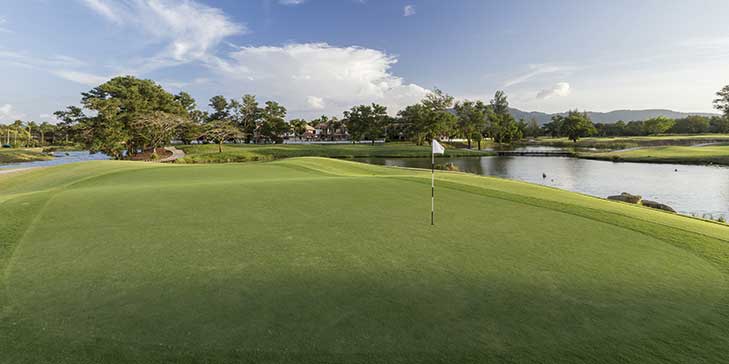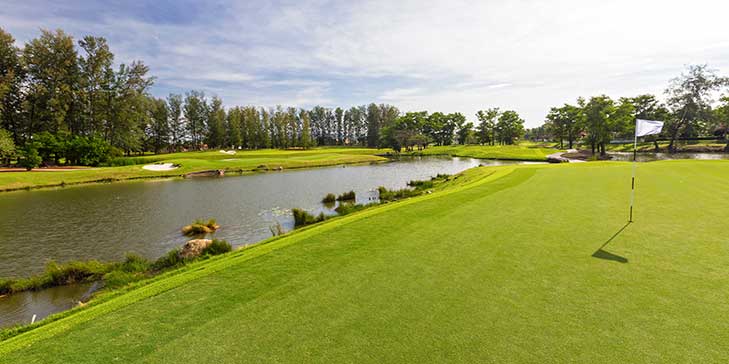Tropical locations are hard places to build golf courses. The tropics are characterised by weather that is virtually always hot and humid and rain events that, when they come, come hard – 100mm (four inches) of rain in one go is commonplace during the wet season.
The result of weather like this is that Pete Dye’s well-known definition of golf architecture – ‘making drainage look good’ – is especially crucial in this environment. In these circumstances it is easy to see a golf project as an engineering exercise before it is anything else, and for playing interest or aesthetic value to fall way down the list of priorities. Engineering a golf course to remove rain on this scale quickly, and so to be playable in a short time after the rain is complex, and it requires compromises that can impact on play –the water has to go somewhere, and therefore a course is likely to include a generous number of water features, just to provide somewhere the rain can drain into.
Banyan Tree hotel company founder KP Ho and his wife found the Laguna Phuket site while holidaying on the island, concluded it would be a great place for a resort and resolved to buy it. What they did not know, at the time, is that the large area of undeveloped land was the remnants of an abandoned tin mine, and the mining operations had left the land in a very poor state. After much work, though, the site was rehabilitated, and the huge resort opened in the middle 1990s. Twenty years on, the thousand acre site includes six large hotels, together providing several thousand rooms – with more on the way – as well as a large number of private homes. It is a huge development, and a stunning success.
Laguna Phuket’s golf course was originally designed by Max Wexler, who has built a number of courses around SE Asia, and David Abell, then an executive with Banyan Tree, and opened in 1992. “It was a pretty straightforward resort course – the fairways were flat and so were the greens, and the whole place was quite open,” says director of golf Paul Wilson. “So we concluded we needed to upgrade the golf course to match the standard of the rest of the resort.”
Wilson and his team engaged architect Paul Jansen to carry out the redesign. Jansen, South African by birth, formerly worked for Nick Faldo’s design practice, but now heads his own firm Jansen Golf Design & Construction – came to Phuket having just finished the new – and highly acclaimed – Laguna Lang Co course on the Vietnamese coast on Faldo’s behalf. The connection to Lang Co is significant.
The Vietnamese course was one of the very first in Asia to use manilagrass (Zoysia matrella) deliberately on its fairways. Matrella is native to the region, and, as Asian Turfgrass Center director Micah Woods wrote in GCA two years ago, is tough and survives even in severe drought conditions. This instinct for survival enables course managers to keep the grass to a strict regime of little water, encouraging firm playing conditions, during the dry season at least. In a region where most golf courses have favoured lush and green over lean and mean, it was a bold choice. And it’s one that Jansen repeated at Laguna Phuket.

“We have designed and graded the ground to help with surface drainage and to create strategic interest,” says the architect. “We have used fairway tiers, mounds, swales and ridges to promote the ground and make golfers think a bit more. Using the manilagrass will also give us the best chance of getting run during the dry months.”
Jansen’s project had two key goals: to make the course more strategically and visually interesting, but also to increase its sustainability. A dramatic reduction in the amount of maintained turf meant that the irrigation system could also be shrunk – from 1,200 irrigation heads previously down to 700 now. Bunkers have also been reduced – the original course had over 100, but now there are only 37.
Jansen reckons creating a connection between the course and its local environment was another key goal. “I want golfers to feel that they are part of a story that is closely linked to the surrounds and history,” he says. “Obviously we looked to highlight the key features on site and off site, such as mountain views, but we have also introduced local furniture – local boats in the water bodies for example – and small detail of this kind help give the course a sense of belonging.”
“Through the construction very little has gone to waste – for instance the trees we removed we have used for steps and benches, for woodchips in the rough areas and for wood-ties on some of our steep slopes,” Jansen says. “We propagated a good portion of the wetland plants found on the site and transplanted them elsewhere on the course or where we have extended the existing water bodies.”
No golf contractor was involved at Laguna Phuket. Jansen, along with his construction-focused colleague, Australian shaper Mark Lawson, who also served as project manager along with superintendent Blair Pratt, were able to handle the whole build using local resources where needed.

But what’s really remarkable about the project is just how entertaining the golf course now is. Wilson’s description of the old course as flat and relatively featureless is hard to countenance given the humpy-bumpy landscape that is now in place. Jansen and Lawson have created a course that is, at least when the weather is dry, an invitation to golfers to play running shots and to use contours to get the ball where they want it.
Perhaps the most remarkable hole on the golf course is the tenth – formerly the first, as the nines were reversed as part of the renovation. A shortish downhill par four, the hole doglegs slightly to the right, and for most golfers, a controlled rather than violent tee shot will be best, to leave the most straightforward pitch possible. The green, steeply built up at the back as a pond sits behind and below, is the most contoured on the course, falling away dramatically from front to back. It is a hole that many golfers will feel they should birdie, but the severe green will make any threes both hard earned and richly deserved.
The tenth may be the most dramatic, but the new-look Laguna Phuket is stuffed full of opportunities to take aggressive lines or play safe. Jansen and Lawson between them have turned that flat and featureless course into something really impressive – while at the same time reducing the maintenance burden for the managers. It is a very smart piece of design and construction indeed.
This article first appeared in Golf Course Architecture - Issue 40